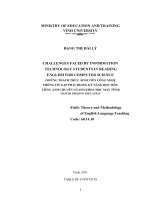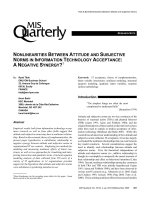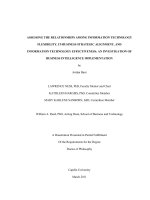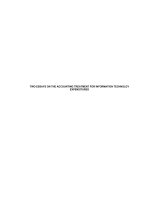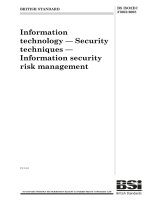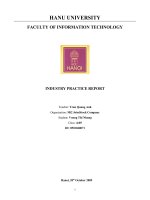Undergraduate curriculum manual information technology
Bạn đang xem bản rút gọn của tài liệu. Xem và tải ngay bản đầy đủ của tài liệu tại đây (1.69 MB, 22 trang )
<span class="text_page_counter">Trang 1</span><div class="page_container" data-page="1">
<b>UNDERGRADUATE CURRICULUM MANUAL INFORMATION TECHNOLOGY </b>
<b>2021 </b>
</div><span class="text_page_counter">Trang 2</span><div class="page_container" data-page="2"><b>I.CURRICULUM 1<small>st</small> Semester </b>
1 LLCT120205E Political Economics of Marxism and Leninism
2
4 MATH143001E Linear Algebra and Algebraic Structure 4
<b>3<small>rd</small> Semester </b>
</div><span class="text_page_counter">Trang 3</span><div class="page_container" data-page="3">5 OOPR230279E Object-Oriented Programming 3
4 CAAL230180E Computer Architecture and Assembly Language 3
<b> Semester </b>
</div><span class="text_page_counter">Trang 4</span><div class="page_container" data-page="4">(*) will be studied in semester 1 for 2021 curriculum onward
<b>Software Engineering Concentration </b>
6 OOSE330679E Object-Oriented Software Engineering 3
<b>Networking and Network Security Concentration </b>
<b>Information System Concentration </b>
6 ISAD330384E Information System Analysis and Design 3
<b>7<small>th</small> Semester </b>
1 ITEN420885E Information Technology Enterprise 2
<b>Software Engineering Concentration </b>
4 MTSE431179E <sup>New Technologies in Software </sup><sub>Engineering </sub> 3
5 POSE431479E Project in Software Engineering 3
<b>Networking and Network Security Concentration </b>
</div><span class="text_page_counter">Trang 5</span><div class="page_container" data-page="5">4 NSEC430880E Network Security 3 5 POCN431280E Project on Networking & Network Security 3
<b>Information System Concentration </b>
<b>General Knowledge Courses (4 credits) </b>
7 IVNC320905E Introduction to the Vietnamese Culture 2
<b>IT Core Elective Courses (12 credits) </b>
</div><span class="text_page_counter">Trang 6</span><div class="page_container" data-page="6"><b>No. Course ID Course Title Credits </b>
3 ITPM430884E Information Technology Project Management 3(2+1)
<b>Specialized Courses (9 credits) </b>
9 NSMS432280E Network Security Monitoring System 3(2+1)
14 OOSD330879E Object-Oriented Software Design 3(2+1)
</div><span class="text_page_counter">Trang 7</span><div class="page_container" data-page="7">18 DLEA432085E
<b>II.COURSE DESCRIPTIONS </b>
<b>Introduction to Information Technology Credits: 3 </b>
Prerequisites: None Course Description :
This course provides students with a broad range of introductory IT concepts; General knowledge of contemporary information technology and job skills required to enter the IT market, especially soft skills. An introduction Computational Thinking and Python programming are also included.
This course provides students with basic programming concepts using C/C++ programming language, knowledge of data presentation in computing, numeric systems, and methods to solve a programming problem. Moreover, this course presents computational thinking, programming styles, approaches to problem-solving and instructions to create console applications using the standard I/O routines in C/C++ with MS Visual Studio.
2) Raman, Rajar. Fundamentals of Computers. Prentice Hall, 2002. 3) Shaw, Zed A. Learn C The Hard Way. Addison-Wesley, 2016.
Prerequisites: None Course Description:
</div><span class="text_page_counter">Trang 8</span><div class="page_container" data-page="8">analysis of efficient algorithms. Students are exposed to various algorithm design paradigms. The module serves two purposes: to improve students’ ability to design algorithms in different areas and to prepare students for the study of more advanced algorithms. The module covers lower and upper bounds, recurrences, basic algorithm paradigms such as prune-and-search, dynamic programming, recursion, big-numbers, divide and conquer, greedy algorithms and some selected advanced topics.
Textbooks:
1) Knuth, Donald E. The Art of Computer Programming Vol. 2– . 3 ed., Addison Wesley, 1997. <small>rd</small>
References:
1) Cormen, Thomas H., et al. Introduction to Algorithms. 3 ed., MIT Press, 2009. <small>rd</small>
2) Kernighan, Brian W., and Dennis M. Ritchie. The C Programming Language. Prentice Hall International Editions, 1997.
3) Lê Minh Hoàng. Algorithms and Programming. University of Pedagogy, Hanoi, 2006. 4) Skiena, Steven S., and Miguel A. Revilla. Programming Challenges. Springer, 2003.
<b>Discrete Mathematics and Graph Theory Credits: 3 </b>
Prerequisites: None
<b>Course Description: </b>
The discrete mathematics part of the course provides students with basic knowledge of sets, propositional logic, predicates and quantifiers, rules of inference, equivalence relations, partial orderings, Boolean functions, representing Boolean functions, logic gates, and minimization of
<b>circuits. The graph theory part of the course provides students with basic knowledge of graphs and </b>
graph models, graph terminologies, representing graphs, graph isomorphism, connectivity, Euler and Hamilton paths, shortest-path problems, introduction to trees, tree traversal, spanning trees
<b>and minimum spanning trees. </b>
1) Dang Truong Son, et al. Discrete Mathematics and Graph Theory. Vietnam National University, Ho Chi Minh City Publishing Company, 2016.
2) Nguyen Huu Anh. Discrete Mathematics. Vietnam National University Ho Chi Minh City , Publishing Company, 2003.
3) Seymour L., and Marc L. Discrete Mathematics. McGraw-Hill Companies, Inc, 2007 4) Tran Ngoc Danh. Advanced Discrete Mathematics. Vietnam National University, Ho Chi Minh
City Publishing Company, 2004.
Prerequisites: None Course Description:
</div><span class="text_page_counter">Trang 9</span><div class="page_container" data-page="9">methods for solving problems (blind, experience, optimization, competition); knowledge of representation and argument, semantic network, expert system, machine learning; knowledge and skills relating to developing smart applications.
References:
Prerequisites: Introduction to programming, Programming Techniques Course Description:
This course provides students with specialized knowledge in data structures and algorithms used for developing computer programs. Students are able to analyse and describe algorithms using pseudocodes as well as develop the algorithms on a computer using C/C++ programming language. Furthermore, this course also provides students with the ability to apply data structures and algorithms to solve real-world problems. Besides, students can work in groups and develop their presentation skills through seminars.
Prerequisites: Introduction to programming Course Description:
Object-oriented programming (OOP) is a programming paradigm based on the concept of "objects", which may contain data, in the form of fields, often known as attributes; and code, in the form of procedures, often known as methods. A feature of objects is that an object's procedures can access and often modify the data fields of the object with which they are associated (objects have a notion of "this" or "self"). In OOP, computer programs are designed by making them out of objects that interact with one another.
This course provides students with specialized knowledge in OOP used for developing application programs. Students are able to write and run programs using C++/C#/Java/Python programming language or JavaScript. Furthermore, this course also provides students with the ability to apply OOP to solve real-world problems. Besides, students can develop their teamwork and presentation skills through seminars.
Textbook:
</div><span class="text_page_counter">Trang 10</span><div class="page_container" data-page="10">1) Harwani, B. M. Learning Object-Oriented Programming in C# 5.0. Cengage Learning PTR, 2015.
References:
1) Chiarelli, Andrea. Mastering JavaScript Object-Oriented Programming. 2 ed., Packt <small>nd</small>
Publishing Limited, 2016.
2) Lafore, Robert. Object-Oriented Programming in C++. 4 ed., SAMS Publishing, 2002. <small>th</small>
3) Phillips, Dusty. Python 3 Object-Oriented Programming. 1 ed., Packt Publishing Limited, <small>st</small>
2015.
4) Skrien, Dale. Object-Oriented Design Using Java. 1 ed., McGraw-Hill Companies Inc., 2009. <small>st</small>
Prerequisites: None Course Description:
This course provides students with a consideration of security problems in computing. Topics include: (1) Foundations: security mindset, essential concepts (Policy, CIA, etc.); (2) Software and OS security: vulnerabilities and protections, malware analysis; (3) Practical cryptography: encryption, authentication, hashing, symmetric and asymmetric crypto; (4) Networks: protocols, attacks and countermeasures
Main textbook:
1) William Stallings and Lawrie Brown (2014), Computer Security, Principles and Practice, Third Edition ISBN-10: 0-133-77392-2
2) Wenliang Du (2017), Computer security a hands-on approach, ISBN-10: 154836794X
3) Matt Bishop (2004), Introduction to Computer Security, Prentice Hall, ISBN 0-321247442
Prerequisites: Introduction to programming Course Description:
This course provides students with fundamental knowledge used to develop web applications based on Servlet and JSP technology. The main contents include (1) Servlet; (2) JSP and JSTL (JSP Standard Tag Library - a collection of useful JSP tags that encapsulate core functionality common to many JSP applications); (3) JDBC; (4) some front-end technologies such as JavaScript and JQuery.
Textbooks:
Hall, Marty, and Larry Brown. Core Servlets & JSP. <small>nd</small>
</div><span class="text_page_counter">Trang 11</span><div class="page_container" data-page="11">Prerequisites: Introduction to programming, OOP, DBMS Course Description:
This course provides students with specialized knowledge and methods in programming on Windows systems. Students are also provided with the fundamentals of ADO.NET to work with different database management systems. Furthermore, students are able to develop different applications using .NET technologies, including windows form controls, graphics controls, LINQ to SQL, Entity framework, Microsoft report. This course also provides students with the ability to apply .NET technologies to solve real-world problems. Besides, students can work in groups and develop their presentation skills through seminars.
Textbooks:
1) Brown, Erik. Windows Form Programming with C Sharp. Manning, 2002.
2) Sells, Chris. Windows Form Programming in C Sharp. Addison-Wesley Professional, 2003. 3) Troelsen, Andrew. C# 5.0 and the .NET 4.5 Framework. Apress, 2012.
Prerequisites: Course Description:
This course aims to provide knowledge and skills related to software engineering, such as receiving requests, modelling the requirement, analysing the requirements, designing the requirements, building software and testing software.
Textbooks:
1) Roger S. Pressman. Software Engineering. Education Publisher, 2001. References:
1) Brooks, Frederick P. The Mythical Man-Month: Essays on Software Engineering. 20<small>th</small>
Anniversary Edition, Addison-Wesley, 1995.
2) Dương Anh Đức. Object-Oriented Analysis and Design with UML. Statistical Publisher, 2002. 3) Larman, Craig. Applying UML and Pattern. Prentice Hall, 1998.
4) Nguyễn Minh Đạo. Education Publisher. FIT - HCMUTE, 2004. 5) Pressman, Roger S. Software Engineering: A Practitioner's Approach. 4<small>th</small>
ed., McGraw-Hill, 1997.
6) Sommerville Ian, . Software Engineering. 9 ed., Addison-Wesley, 2011. <small>th</small>
Prerequisites: OOP
</div><span class="text_page_counter">Trang 12</span><div class="page_container" data-page="12">Course Description:
This course provides students with fundamental knowledge about software analysis and design using object-oriented techniques, Unified Modelling Language (UML) and UML tools, as well as design patterns and their applications in software development. By the end of the course, students will be equipped with analysis and design skills, such as the ability to use UML tools to create software design components and the ability to apply appropriate design patterns in various situations to improve software resilience and extensibility. Moreover, soft skills such as teamwork and public presentation are also developed during the course.
1) Cooper, James W. The Design Patterns Java Companion. Addison-Wesley, 1998. 2) Horstmann, Cay. Object-Oriented Design & Patterns. 2 ed., John Wiley & Sons, 2006. <small>nd</small>
3) Larman, Craig. Applying UML and Patterns: An Introduction to Object-Oriented Analysis and Design and Iterative Development. Pearson, 2008.
4)
<b> </b>
Prerequisites: Software Engineering Course Description:
This course provides students with specialized knowledge in software development life cycles, software development models, software testing, software testing processes, fundamental designing and implementing testing techniques. After finishing the course, students will be able to understand terms, definitions, and concepts in software testing and they will be able to apply knowledge to design, execute, analyse and evaluate software quality. Besides that, students will have the opportunity to do practical work using bug management tools and automation testing tools.
2) Myers, Glenford J. The Art of Software Testing. John Wiley & Sons, 2004.
3) Nguyen, Hung Q. Testing Application on the Web: Testing Planning for Mobile and Internet-Based System. Wiley Publishing, 2003.
<b>Modern Technologies on Software Engineering Credits: 3 </b>
Prerequisites: Web programming
</div><span class="text_page_counter">Trang 13</span><div class="page_container" data-page="13">Course Description:
This course provides students with the ability to build an application using the MEAN stack by writing as little code as possible and taking a high-level view of the key components along the way. The students will use as many abstractions and templates as possible.
MEAN is an acronym for the four main technologies (1) MongoDB: A non-relational database; (2) ExpressJS: A node framework that has powerful middleware features; (3) AngularJS: A frontend JavaScript library created and maintained by Google that is used to create single-page applications; (4) Node.JS: A server-side JavaScript environment based on V8.
Textbook:
1) Holmes, Simon. Getting MEAN with Mongo, Express, Angular, and Node. Manning Publications Co., 2016.
References:
1) Haviv, Amos Q. MEAN Web Development. Packt Publishing, 2014.
Prerequisites: Web programming Course Description:
This course provides students with fundamentals used to develop Android Applications. The main contents include Java concepts, Android Platform concepts, Android Application Structures, Android Libraries, and Android User Interface Design. After finishing this course, students will be able to analyse, design and choose appropriate libraries for developing full-stack Android Applications.
Textbooks:
1) Darwin, Ian F. Android Cookbook. O’Reilly Media, 2012. 2) Lee, Wei-Meng. Beginning Android Development. Wrox, 2012. References:
1) Lee, Wei-Meng. Beginning Android Development. Wrox, 2012.
Prerequisites: Information security, Web programming Course Description :
This course provides students with knowledge about the major risks and basic popular attacking types into Web applications. This course also presents some defending methods against such types of attacks. The course also equips students with the knowledge and the ability to identify threats and use appropriate tools and techniques to build a safe web application and protect it from attacks.
</div><span class="text_page_counter">Trang 14</span><div class="page_container" data-page="14">2) OWASP Top 10 - 2013.
<b>Prerequisites:none </b>
Course Description:
This course provides students with basic terminology in information technology project management, especially software project management. The course focuses on major knowledge areas involved in the software management process, including project planning, scope management, requirement and change management, time and cost management, risk and human resource management. In this course, students are also equipped with basic skills in project planning and various project management activities.
1) Chemuturi, Murali K., and Thomas M. Cagley Jr. Software Project Management: Best Practices, Tools, and Techniques. J. Ross Publishing, 2010.
2) Hughes, Bob, and Mile Cotterell. Software Project Management. 5<small>th</small>
ed., McGraw-Hill, 2009. 3) Jalote, Pankaj. Software Project Management in Practice. Addison-Wesley, 2002.
Prerequisites: Mobile programming Course Description:
Ionic teaches web developers how to build cross-platform mobile apps for phones and tablets on iOS and Android. Students will learn how to extend their web development skills to build applications that are indistinguishable from native iOS or Android projects.
Textbooks:
1) Ravulavaru, Arvind. Learning Ionic. Packt Publishing, 2015. References:
1) Bohner, Michael. Building Mobile Apps with Ionic Framework. Michael Bohner, 2015. 2) Wilken, Jeremy. Ionic in Action. Manning Publications Co, 2016.
Prerequisites: Database Course Description:
This course covers the fundamentals of database architectures and database systems, focusing on basics such as the data model, relational algebra, SQL and query optimization. The course also features database design and relational design principles based on dependencies and normal forms. It is designed for undergraduate students; no prior database experience is assumed.
Textbook:
</div>
